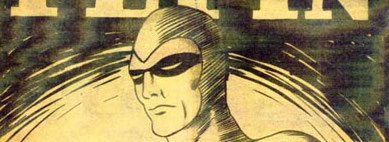Comics of Mexico, Central America, and the Caribbean
Regions: Mexico

Mexico, Central America, and the Caribbean share a rich comics tradition that dates back to the early twentieth century and continues to evolve through a combination of global trends and diverse local impulses. The region’s comic book and graphic narrative production has been largely dominated and influenced by Mexico, which in the mid-1900s developed a comic book industry and readership unrivaled in Latin America. Cuba has also produced important comic book artists and publications, while elsewhere in the region comics have typically remained a lesser art that has received limited international exposure and even less academic attention.
Mexico’s first comic books appeared in the early 1930s, but precursors of the country’s comic art industry had already made their appearance at the beginning of the century. These included Panchito El Corto (1911), the main character of stories that appeared in the Sunday supplement of El Imparcial newspaper, and El Heraldo’s Don Catarino comic strip (1921). As the newspaper industry grew in Mexico during this period, the main dailies competed for readers by trying to have the best Sunday funnies. Starting in the late 1920s, these supplements included translations of foreign comics such as Tarzan. But soon, locally produced comics began to appear in the dominicales. Early Mexican cartoonists drew on the country’s long tradition of popular graphic art, more recent post-revolution social-realist imagery, and also the style of U.S. cartoonists.
Sunday funnies led to full-fledged comics—or historietas—beginning with Adelaido el Conquistador, which featured a character of the same name that appeared in an El Universal daily strip. It survived for only 100 weekly issues between 1932-33. However, Adelaido set the stage for more successful comic books that would follow in its footsteps. These included Paquín (1934), the first comic to find a wide audience; Paquito (1935); Chamaco (1936); and Pepín (1936), the most popular of these pioneering comics. Gabriel Vargas’s La Familia Burrón, the country’s longest-running comic book, also got its start in the 1930s. Focusing on a male-female role reversal, the comic is rich is social satire against the privileged and in favor of the poor.
By 1940, historietas were everywhere, having quickly become as common as radio and even more popular than the movies. Reasons for this success included the growth of a new literate working class audience beginning in the 1930s, an expanding economy that allowed the masses to spend money on cheap entertainment, and a vibrant publishing industry that took advantage of this market. In 1943, it was estimated that Mexicans purchased half a million comic books a day For example, at its peak in the late 1940s, Pepín alone printed as many as 300,000 copies daily. By 1950, the daily historieta began to decline and a new trend started among publishers, which began targeting specific audiences with their titles: fans of bullfighting, ranchera music, romantic stories, women wanting fashion advice, etc. Comic books about famous pop culture figures such as luchador Santo and actor/singer Pedro Infante were common during this time. The period from the 1930s to the mid 1950s is generally considered the golden age of Mexico’s comics.
One of the biggest sellers in the history of Mexican comic books and a beloved comics hero is Memín Pinguín, a character created in the 1940s by prolific historieta writer Yolanda Vargas Dulché and drawn by Alberto Cabrera. A mischievous but good-hearted Afro-Mexican boy, Memín remained enormously popular well into the 1980s and continues to be published weekly, although the comic book has stirred controversy (particularly in the United States) for its stereotypical portrayal of blacks and its alleged racism. Also extremely popular all over Latin America was the superhero comic series Kalimán, created in 1965 by Cuban exile artist Modesto Vásquez González and Mexican writer Rafael Cutberto Navarro. At its peak, it sold 2 million copies weekly. Mexico also has a rich tradition of political cartooning, led by Eduardo del Río (Rius), who in the 1960s created Los Supermachos and Los Agachados, which offered humorous criticism of the Mexican government. Marx for beginners, the 1976 English translation of Rius’s comic book Marx para principiantes (1972), became an international bestseller.
The 1970s brought about a period of relaxed controls in terms of censorship in Mexico, which was reflected in the comics industry’s opening toward explicit material and pornography, including publications such as María by Zótico Fonseca and Gustavo Galán’s La Mosquita. This was also the time of clandestine innuendo circulating in Tijuana Bibles and the spicy parodies of Chanoc, a hero of Mayan descent. Fotonovelas—short publications similar in format to comic books but with photographs instead of illustrations—reached their heyday during the 1960s and 1970s, particularly those specializing on Cinderella-type romances and on soft pornography. In the late 1970s, fotonovelas were second in popularity only to the movies, with 70 million copies published monthly.
Harold Hinds and Charles Tatum have stated that Mexico and Japan are the world’s only comic book cultures. At its peak, Mexico was the world’s largest per capita consumer of comics, with 36 million readers in 1977 and 250 million copies read monthly in the 1980s. However, this great comic book publishing machinery eventually fell into decline and the model of the Mexican historieta for the masses vanished by the end of the century, losing nine out of 10 readers, particularly to television dramas and comedies. But comics have not gone away in Mexico. Beginning in the 1980s, the country saw the rise of alternative and auteur comics as well as inventive and bold cartoons with varied styles. New artists, such as Rafael Barajas Guzmán and José Palomo Fuentes, have paid little attention to the industrial historieta and embraced comics as a means of personal expression. During the 1990s, El Gallito magazine published some of the best Mexican alternative comics, including Edgar Clément’s mythological and revisionist saga Operación Bolívar. Recent comics—such as Polo Jasso’s El Cerdotado—tend to sarcastically draw attention to issues of corruption and crime in contemporary Mexico, while coexisting with more commercial works that focus on themes of opulence and teen lifestyle, such as the telenovela-inspired Rebelde.
In addition to Mexico, Cuba has a long sequential art tradition. In the late 1930s, comics appeared in the country’s main newspapers, including Mike Cárdenas’s Un Gran Muchacho (El País) and Horacio Rodríguez Suria’s Profesor Timbeque (El País Gráfico). As the Cuban Revolution raged on during the 1950s, a few comic strips stood by the side of rebel leader Fidel Castro or otherwise served his purposes. One of the most important anti-Batista strips was Pucho y Sus Perrerías, by Marcos Behemaras and Virgilio Martínez Gaínza, published in the clandestine political magazine Mella (1955-59). After 1959, Mella and Revolución published comic strips and weekly comics supplements. Ediciones en Colores started four monthly comics magazines, while Palante and Pionero humor magazines opened the way for many cartoonists to develop their craft. After 1965, political and strip cartoons appeared in the two main dailies that emerged out of the early revolutionary years, Granma and Juventud Rebelde. They were joined by various humor and specialized magazines, including Dedeté (created in 1979), which along with Palante has survived into the twenty-first century. The Latin American economic downturn of the early 1990s particularly impacted Cuba, severely hurting newspaper publishing and decimating comics production in the island into the new millennium.
Elsewhere in the region, there have also been notable comic book artists and innovative works. One of Puerto Rico’s most beloved comic books is Ricardo Alvarez Rivón’s Turey el Taíno, which taught readers about the culture of the island’s native inhabitants from 1989-2006. The Puerto Rican folk character Juan Bobo has also been featured in comic books and other publications since the early 1900s. Róger Sánchez Flores stands out among Nicaraguan comic book artists, publishing political cartoons after the 1979 Sandinista Revolution and authoring a magazine feature called “Humor Erótico,” which is considered unique in Latin American cartooning because of its subversive nature and challenges to traditional attitudes about sexuality. Another well-known Central American cartoonist is Hugo Díaz (Costa Rica), who illustrated numerous books, drew political cartoons, and created educational comics for the regional Escuela para Todos almanac and magazine during the mid and late 1900s. Central America has also exported comics talent, including Panama-born Jorge Cham, creator of the popular comic strip PhD Comics.
— Mauricio Espinoza
Further Reading
- Campbell, Bruce. ¡Viva La Historieta! Mexican Comics, NAFTA, and the Politics of Globalization. Jackson, MS: University Press of Mississippi, 2009.
- Fernández L’Hoeste, Héctor and Juan Poblete, eds. Redrawing the Nation: National Identity in Latin/o American Comics. New York, NY: Palgrave MacMillan, 2009.
- Hinds, Harold E. and Charles M. Tatum. Not Just for Children: The Mexican Comic Book in the Late 1960s and 1970s. Wesport, CT: Greenwood Press, 1992.
- Lent, John A. “Cuba’s Comic Art Tradition.” Studies in Latin American Popular Culture 14 (1995): 225-244.
- Lent, John A., ed. Cartooning in Latin America. Cresskill, NJ: Hampton Press, 2005.
- Rubenstein, Anne. Bad Language, Naked Ladies, and Other Threats to the Nation: A Political History of Comic Books in Mexico. Durham, NC: Duke University Press, 1998.


